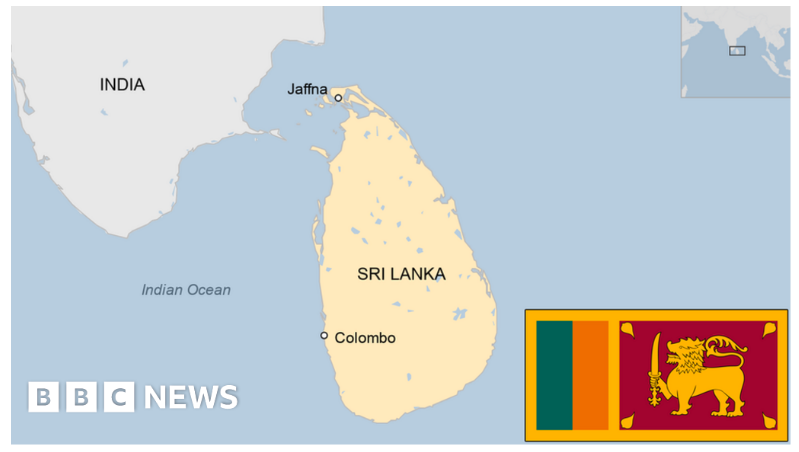Context:
Recently, India and Sri Lanka released a joint statement on economic cooperation, outlining a forward-looking vision for their relations.
- Titled: “Promoting Connectivity, Catalysing Prosperity: India-Sri Lanka Economic Partnership Vision,”.
 Image Source: BBC
Image Source: BBC
Key outcomes of the joint statement on economic cooperation between India and Sri Lanka:
- Vision for Future Relations: The joint statement outlines a forward-looking vision for the bilateral relationship, focusing on five key areas: maritime, air, energy, trade, and people-to-people initiatives.
- Infrastructure Development: New investments in maritime and air connectivity involve developing ports and airports in Sri Lanka, resuming ferry services, and expanding flight networks to connect Tamil Nadu and Sri Lanka’s Northern and Eastern Provinces.
- Energy Connectivity: A major surge in energy connectivity is planned, with the development of renewable energy wind and solar plants in Sri Lanka.
- Support in Sri Lanka’s Economy: India will continue to support Sri Lanka’s economy, which faced challenges last year and is undergoing debt restructuring.
- Digital Payments and Currency: A memorandum of understanding was signed to operationalize UPI digital payments in Sri Lanka and designate the Indian Rupee as currency for trade.
- Tourism and Collaboration: Both countries will explore ways to enhance tourism, cultural and religious travel, and educational collaboration.
Lack of Acknowledgment:
- Vision statement omits previous commitments on the 13th Amendment for devolution of powers to North and East provinces.
- India has been pressing Sri Lanka to fully implement the 13th Amendment as the answer to the Tamil demand for political autonomy for the Northern and Eastern regions.
About the 13th Amendment of Sri Lanka:
- The 13th Amendment of Sri Lanka is a significant constitutional amendment that was introduced in 1987 as part of the Indo-Sri Lanka Accord.
- It created 9 provinces as devolved units with a temporary merger of the Northern and Eastern provinces.
- The amendment was aimed at resolving Sri Lanka’s ethnic conflict, which had escalated into a civil war between the government’s armed forces and the Liberation Tigers of Tamil Eelam (LTTE).
Key Features of the 13th Amendment:
- Creation of Provincial Councils: The amendment led to the establishment of Provincial Councils in all nine provinces of Sri Lanka, allowing for power-sharing arrangements and self-governance.
- Devolution of Powers: Provincial administrations were given control over subjects like education, health, agriculture, housing, and land.
- Unimplemented Provisions: However, certain aspects, such as police and land powers, were never fully implemented, leading to challenges in the functioning of the Provincial Councils.
- North-Eastern Provincial Council: Initially, the northern and eastern provinces were merged to form the North-Eastern Provincial Council. However, they were later de-merged in 2007 following a Supreme Court verdict.
Why is it Contentious?
- Opposition from Sinhala Nationalists: Some Sinhala nationalist parties and groups opposed the amendment, viewing it as granting too much power to the provinces and a threat to the unitary nature of the country.
- Opposition from LTTE: The Liberation Tigers of Tamil Eelam (LTTE) vehemently opposed the 13th Amendment, considering it insufficient in addressing the Tamil community’s demands for self-determination and a separate state.
- Perceived Imposition: The Accord and the subsequent legislation were seen by a large section of the Sinhala polity as an imposition by India, perceived as a dominant neighbor wielding hegemonic influence over Sri Lanka’s affairs.
- Lack of Full Implementation: Certain provisions of the 13th Amendment, particularly those related to police and land powers, have not been fully implemented, leading to skepticism about the amendment’s effectiveness.
- Differing Perspectives: The Tamil polity, especially the dominant nationalist strain, does not view the 13th Amendment as sufficient in addressing the Tamil community’s aspirations for autonomy and political power.
Challenges for India:
- Implementation Delay: The 13th Amendment’s full implementation has been slow and faced challenges, which has been a concern for India. The delay in fulfilling the aspirations of the Tamil community has led to tensions in India-Sri Lanka relations.
- Ethnic Tensions: The Tamil demand for political autonomy has a long history of conflict in Sri Lanka, and India’s advocacy for the 13th Amendment has been met with differing responses from various Sri Lankan governments.
Conclusion:
- Despite the strong familial bonds between the two countries, historical challenges have tripped up ties in the past.
- A vision for the future that does not include an amicable resolution of these issues may be considered incomplete, and it remains a challenge to find a path forward that addresses these sensitive matters while promoting economic cooperation and connectivity.
News Source: The Hindu
![]() 25 Jul 2023
25 Jul 2023
 Image Source: BBC
Image Source: BBC